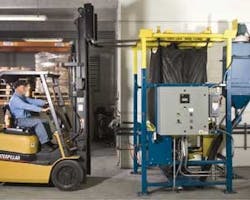New Low Pressure High Output UV System Requires Fewer Lamps
Ultraviolet treatment has had a prominent and growing place in wastewater disinfection for almost 30 years, but the UV dose required by reuse guidelines has led to system designs containing previously unimaginable numbers of lamps. The industry has been challenged to develop UV systems that maintain high germicidal efficiency while keeping the lamp count to a reasonable number.
Germicidal efficiency is comprised of both electrical efficiency (lamp and ballast characteristics), and hydraulic efficiency, (how well the germicidal light is applied to the effluent). UV manufacturers usually develop a product for the secondary effluent market and then apply the same product for reuse applications with little or no modifications. Using a product designed for secondary effluent for high dose reuse applications results in lamp counts that become cumbersome.
This challenge led Calgon Carbon to develop the C3500™D UV system with the reuse market in mind. By using patent-pending Delta-shaped mixing devices to efficiently treat wastewater with 500-watt lamps, the company has been able to keep lamp count to a minimum.
The UV disinfection system uses patent-pending mixing devices to help keep lamp count to a minimum.
Initial R&D using Calgon Carbon's Computational Fluid Dynamics (CFD) analyzed the UV reactor without mixing devices. The analysis revealed that there was a high fluence rate around the lamps and a low fluence rate between the lamps. When using the Delta mixing technology, however, the fluence becomes more uniformly distributed within the lamp array – allowing for significant improvement in UV disinfection efficiency.
To drive the C3500™D project forward, Calgon Carbon's research and development group identified several configurations that would meet reuse requirements set by the National Water Research Institute (NWRI). To further test the application, Calgon partnered with the University of Toronto to perform preliminary testing of the different configurations so that the CFD model could be calibrated and the best configuration could be identified. After optimizing the lamp and Delta device configuration, the company hired Carollo Engineers to validate the C3500™D system at the Stockton, CA, Wastewater Facility Plant.
As part of the validation process, both low dose and NWRI reuse testing were conducted and a completed Validation Report was submitted to the California Department of Public Health in July 2009.
The validation performed at Stockton employed two non-pathogenic indicator viruses - MS2 coliphage (MS2) and T1 coliphage (T1). The data was then used to develop empirical equations which can be applied to any organism with a known UV sensitivity (dose per log inactivation). This validation approach allows Calgon Carbon to guarantee the system performance for a given organism for customers.
A case study prepared by Carollo Engineers for the City of Stockton compared two different lamp technologies (low and medium pressure) from four different vendors to implement UV disinfection at their 55 mgd facility. The study compared installation costs, O&M, and life cycle costs for three different MS2 Reduction Equivalent Dose levels (110, 70 and 50 mJ/cm2) per the NWRI guidelines. The C3500™D provided the lowest installation, O&M, and life cycle cost under all conditions. Carollo Engineers presented the results of the case study at the 2009 IUVA conference in Boston, MA.
Validation testing confirmed that the swirling action generated by the Delta-shaped devices more uniformly exposes water to the UV light. The C3500™D uses calibrated UV sensors and the flow rate to control the dose – helping to minimize operating costs and provide longer lamp life. And, because the C3500™D uses fewer lamps than other LPHO systems, that means a smaller footprint as well as decreased installation, and operation and maintenance costs.
As a result of the validation testing and the empirical equations developed, Calgon Carbon is able to guarantee the log removal of several different organisms. This capability led Christies Beach, Australia, to select the C3500™D UV disinfection technology for its wastewater reuse treatment plant. The treated effluent will be recycled for internal plant use, discharged to an off-site reuse scheme, or discharged to a marine environment. Start-up is scheduled for late 2010. WW

